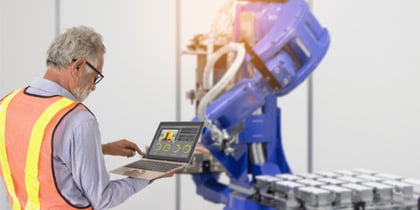Across industries, workplace culture is a hot topic. The culture at your own workplace might be “I know it when I see it” – hard to describe in specific terms but noticeable when it changes. Some ways to think of workplace culture are:
- What it feels like to work somewhere
- How the work environment affects each person’s ability to get their work done
- The general organization of people and tasks
- Employees’ camaraderie and sense of community or support
Automation drives cultural changes in all aspects of work. In this post, we’ll talk about how automation affects culture in terms of the work that’s done: tasks and efficiencies as well as the overall approach to manufacturing. In part 2 of this blog, we look at how automation affects the human side of culture.
A New Approach to Everyday Tasks

In most cases, companies decide to add robotics and automation equipment in response to needs for increased production and efficiency, not as an attempt to reduce staff. In fact, automating the repetitive, simple, and high-volume work is a way to deploy workers more effectively by freeing up skilled workers for more complex jobs or high-mix work where robotics may not be suitable.
Common side-effects of automation are faster time cycles, changes to the order of steps or procedures, and removing as much decision making and subjectivity from the manufacturing process for a task as possible. The more a job can be mechanized and broken into repeatable tasks, the less opportunity for human error or inconsistency.
As a result, there are new, strict expectations for prep of components, from cutting a basic shape accurately to positioning the workpiece in the machine. Everything must match the operating parameters of computerized equipment.
And for operators, the goal of a day’s work changes. Instead of pacing their manual activity over the course of an eight-hour shift, they’re focused in maximizing machine uptime. This means anticipating the machines’ movements and getting the timing right for staging, loading, and unloading.
Moving Toward Continuous Improvement
Automation often brings a mindset of continuous improvement that spreads throughout the facility. For example, if a robotic welder makes one end of the assembly line faster, would adding an automated palletizer at the other end save even more time? Or could it result in fewer damaged products, or reduce labor needs for that production line, or even all three?
Once people see automated systems in action, it gets easier to identify further applications and potential benefits – after a while it just “clicks” and new applications become apparent. In some cases, just being around the precision and repetition of the machines helps people discover ways to better organize and streamline manual tasks too.
Learn More in our eBook: Working with an Automation Vendor
New Data Points, New Opportunities
Automation helps people see things in new ways. As we said above, this can be based on observation of machines in action, but also because of the data collected by the machines themselves. For example:
- Collecting and studying machine performance and productivity data pinpoints areas that consistently lag behind or cause bottlenecks. That makes it easier to know exactly where to start making adjustments.
- Production data points out pockets of extra time that can be used for developing a new product, making a stockpile of high-demand components, or taking on new customers and opportunities.
- Many machines include predictive analytics and preventive maintenance data, such as monitoring fluid levels or critical temperatures. This allows you to plan for maintenance and part replacement well in advance rather than being surprised by a repair and unplanned downtime. And having a constant “eye” on machine conditions makes it easy to catch and fix problems quickly.
- Monitoring data also helps you understand your baseline production capabilities so you can pivot quickly if the market changes.
In this post we’ve looked at ways automation changes the tasks and work at a manufacturing facility, and how a mindset of continuous improvement and can lead to new opportunities. In part two, we look at some of the ways automation impacts the human side of manufacturing. In the meantime, please get in touch to talk about opportunities for automation in your organization!



